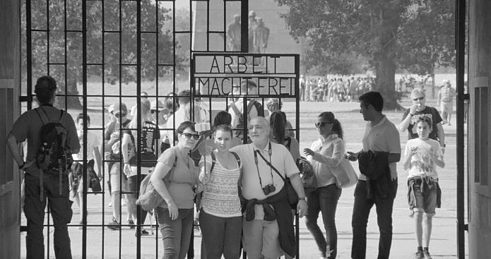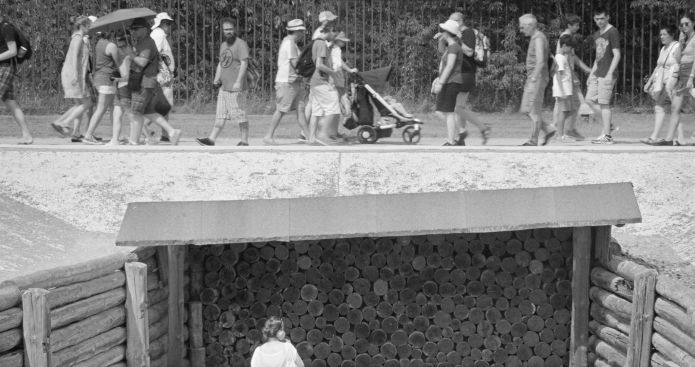Sydney Film Festival 2017
Austerlitz: Humanity in the face of horror

Austerlitz: "Arbeit macht Frei" | © Imperativ Film
How does humanity cope in the face of unspeakable tragedy? It’s a question that has been asked countless times on film, in countless features about horrors big and small, universal and intimate, real and fictional — indeed, it’s one with as many cinematic depictions as answers.
Some people are moved to act, or at the very least exclaim in astonishment. Others are paralysed by their emotions, unable to move or speak. Some need time to contemplate. Others choose not to engage, opting to wander, meander, or either willingly or automatically seek distractions. Many retreat into denial, carrying on as though nothing unusual has happened.
Watching People Walk
All of these reactions fill the frames of Austerlitz, which ponders the same query not by depicting or chronicling troubling events as they occur, but by observing tourists while they walk through the Dachau and Sachsenhausen concentration camps in Germany. In keeping with the approach favoured in his previous efforts such as Maidan and The Event — his two most recent documentaries, which explored Ukrainian unrest and a failed Russian coup, respectively — director Sergei Loznitsa lets his sounds and images do the talking. Presented sans narration and explanation, to watch his film is to simply watch people walk in the footsteps of atrocity and wear their natural, instantaneous unguarded responses.Or is it? As 94 minutes in the documentary’s company demonstrates, bearing witness to the behavior of others as they confront the echoes of brutality is a complicated task. Named for and inspired by German author W.G. Sebald’s 2001 novel, which touches upon the influence that memorials have on our collective recollection of history, Austerlitz seems deceptively straightforward; and yet, contained within compilation of visitors gazing at places where lives were cruelly taken is a multifaceted portrait of life. Showing how we interact with and interrogate the past — or don’t in anything beyond a superficial nod, as is evident in many cases — sits at the documentary’s centre. Accordingly, Loznitsa’s feature acts as a window and a mirror combined: peering at reality without imparting any external sentiment upon it, while forcing viewers to see themselves in its ordinary sights.
“Cool Story Bro”
So it is that, acting as his own cinematographer alongside Jesse Mazuch, the Ukrainian filmmaker records everything that flutters in front of fixed cameras set up at specific spots within the sites. He doesn’t move the black-and-white frame, follow anyone in particular, zoom in or out, or direct the audience’s attention in any way; nor do his many subjects show any sign of knowing they’re being filmed. Nothing remarkable takes place, as people walk through gates, corridors, rooms and ruins, listen to guides, talk amongst themselves, snap photos, answer phone calls and just generally do what people do. And yet, everything is remarkable. The documentary itself is remarkable. Revelations surge forth like the masses, from the juxtaposition of official signage stating “Work Sets You Free” with t-shirts emblazoned with “Cool Story Bro”, to the sight of smiling faces in such darkness-tainted places, to the sounds of melodic ringtones interrupting snippets of tour spiels detailing the extent of the devastation that took place. Austerlitz is screening at the 2017 Sydney Film Festival.
| © Imperativ Film
Loznitsa revels in these contrasts, just as he revels in all of the complex details captured. There’s many of both. The latter feeds the former, and viewers can only let their eyes roam, their ears soak in the chatter, and wait for connections to form. As the crowd ebbs and flows, it’s impossible not to think of the previous cohorts that trudged across the same ground — though that’s yet another of the many comparisons the film aims to evoke. Another, of course, is the fact that Austerlitz’s audience are paying much more attention to these trips through the camps, what they symbolise and what touring such places means, than the majority of those seen on screen.
Austerlitz is screening at the 2017 Sydney Film Festival.
| © Imperativ Film
Loznitsa revels in these contrasts, just as he revels in all of the complex details captured. There’s many of both. The latter feeds the former, and viewers can only let their eyes roam, their ears soak in the chatter, and wait for connections to form. As the crowd ebbs and flows, it’s impossible not to think of the previous cohorts that trudged across the same ground — though that’s yet another of the many comparisons the film aims to evoke. Another, of course, is the fact that Austerlitz’s audience are paying much more attention to these trips through the camps, what they symbolise and what touring such places means, than the majority of those seen on screen.